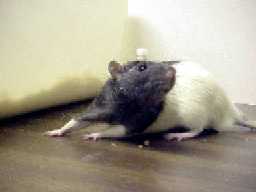Research: (under constant
change)
I am interested in understanding
the processes and mechanisms involved in learning and in how memories are
formed.
My research and interests are guided by questions such as: How do we learn?
What changes occur in the brain when we learn? What chemicals and processes
are
critical
for
producing
those
changes?
Over the years I have used a number
of techniques to investigate issues related to the central question of how
we
as humans learn. The techniques I've used include: histology,
electrophysiology, pharmacology and behavior.
Most recently, experiments have
been conducted with assistance of undergraduate students at Oberlin College
addressing the role of certain proteins (voltage dependent calcium channels)
in the formation of long-term memories. Some of these students have
since moved on to research laboratories or graduate programs.
For example, my first Honor's student, Alex Goddard, is currently working
on
his Ph.D. in Neuroscience at Harvard, Bonnie Fletcher is at NYU. More recent
graduates are working in New Zealand at the University of Aukland (Wes Clapp),
and at Boston University (Lara Petrak).
The rest of this page highlights
some
of the work done by Oberlin students in my lab. Even though some never made
it to publication, much of it was very illuminating within the context of
the question being asked.
some photos taken by Gisela Knight
[ Home ] [Classes ] [Travel]
[Research] [OCTET]
|
In
vivo induction of vdccLTP and nmdaLTP
Honor's Project '99-'00 (Bonnie Fletcher)
continued into Summer Research '00 (Bonnie Fletcher, Lara Petrak, Kunal
Dalal)
|
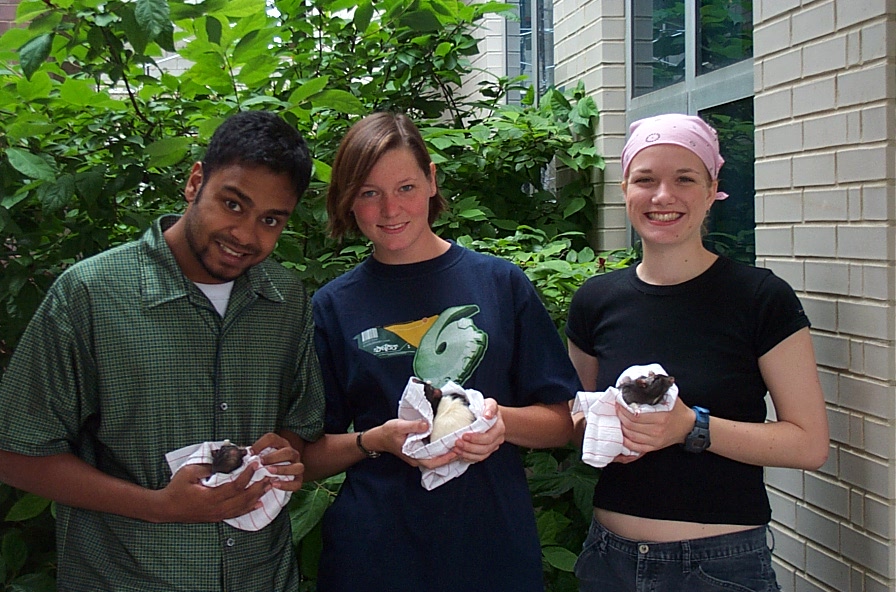
Kunal Dalal ('01), Bonnie Fletcher ('00) & Lara Petrak ('01)
|
|
This project asked the question "Would the presence of voltage
dependent calcium channel antagonists prevent the induction of LTP induced
in vivo (i.e. in an awake moving animal)." The question arose from
a report in which researchers at other laboratories had shown that there
seem to be two forms of synaptic modifications that can occur. The first
requires the activation of NMDA receptors and is short lasting. The
second requires activation of voltage dependent calcium channels and
is longer lasting. These results were demonstrated in vitro and in anesthetized
animals. However, in vitro preparations and anesthetized animals are
not necessarily do not reflect the state of neuronal tissue as it normally
is when it is learning!
This project was incredibly difficult. 4 electrodes needed to be implanted.
A recording electrode was placed in the CA1 region of the right hippocampus.
Two stimulating electrodes were positioned in the CA3 region, one on the
right and one on the left side. The fourth electord was a ground wire
placed around the nearest screw. Electordes and the head assembly were
then cemented into place. Subjects were run 2 at a time and changes in
evoked responses were monitored over a 10 day period. Results were mixed
and did not allow for any conclusion to be reached. However, much technical
information was gathered. Therefore the question of whether or not VDCC
LTP is evident in an awake moving animal is still open. |
|
|
| More
Pictures |

Effect
of post trial injections of verapamil on learning in the radial arm maze.
Honor's Project '99-00 (Wes Clapp)
|
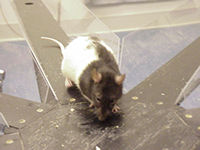
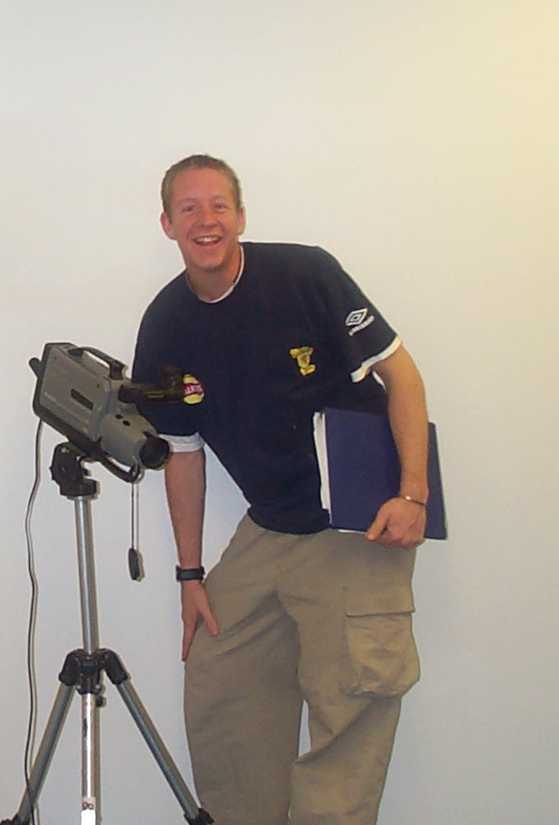
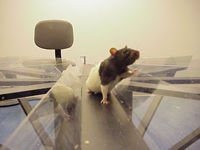

|
Effect of blocking NMDA and voltage
dependent calcium channels on working and reference memory as measured
by using a 8-arm radial maze.
Winter Term Jan '99
This work has since been published in the Journal
of Neuroscience.
Albert M. Borroni, Harlan Fichtenholtz, Brian L. Woodside, and Timothy
J. Teyler Role of Voltage-Dependent Calcium Channel Long-Term Potentiation
(LTP) and NMDA LTP in Spatial Memory J. Neurosci. 2000 20: 9272-9276.
Harlan Fichtenholtz was a student here at Oberlin when
the work was done as were many of the other students who worked on this
project.
|
- supported by the Winter Term Committee and the Neuroscience
Department at Oberlin College.
| Click
on image to see larger version




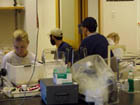

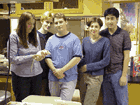
|
Short rationale behind this project.
Activity dependent calcium increases in neurons is important for changing
the strength of connections between neurons. This process is thought
to be important for the formation of memory. While it is known that
the blockade of NMDA channels (one means for increasing intracellular calcium)
can prevent rats from learning the nuances of an 8-arm
radial maze, it is not known what effect the blockade of voltage dependent
calcium channels (VDCCs - another means of increasing intracellular calcium)
will have on a similar task. This project was designed to discover if calcium
entry via VDCCs might also be involved in the learning of the 8-arm radial
maze. More details about the background and procedure
are described elsewhere.
During this winter term 2 8-arm radial
mazes located in the Sperry building were continually in use from
11:00am - 8:30pm. This was made possible by the diligent work habits
of nineteen students (see left margin) and the quick and beautiful
work of Bill Martin in the machine shop. Students were divided into
8 groups (2-3 students/group). Each group was responsible for 4 rats.
Students injected, ran the rats daily (including 2 weekends) and
scored the rat's progress. Bonnie Fletcher and Harlan Fichtenholtz
were assigned to deal with data analysis and students from my Neurobiology
of Learning and Memory laboratory were in charge of overseeing certain
timeslots.
The project was a huge success. I've
was very happy with the effort and care that the students have taken in
being on time and being gentle with the animals. Also I would like to thank
those that provided space and funding: Neuroscience Dept., Winter
Term Committee and the Dean's Office. Further thands to Dr. Teyler
who helped design this study and Gigi Knight. All procedures were approved
by IACUC (#99RNAB1).
Preliminary Results !!
With respect to learning which arms had food
in them and which didn't (reference memory -RM), the group
of animals given the VDCC blockers learned the task well, but failed to
retain it. The group of animals given the NMDA blocker didn't learn
as well, but retained their learning over the retention interval...and
even got better! The combined drug group learned the worst of all,
and didn't retain their meager learning over the retention interval.
With respect to learning not to reenter an arm where
they already found food (working memory -WM), all groups did
pretty well except for the combined drug group who showed a lot of WM errors.
With respect to performance on the first and second
trials of each day, there does not seem to be a clear pattern with
respect to RM errors. On WM errors, however, most drug groups
show fewer errors on the 2nd trial. This reduction in reference errors
is most evident in the group where both NMDA and VDCC channels were blocked.
Graphs - page
is not optimized and therefore may take some time to load!
Conclusion
Blocking VDCCs does affect learning. Verapamil (VDCC
antagonist) and MK801 (NMDA antagonist) differentially affect learning
as assayed by comparing reference errors and the ability of the animals
to retain the information over a period of 1 week.
The combined drug seems to have an effect on learning
that is more than the sum of the individual drugs alone.
Further studies that have been suggested:
-
Testing the ability of these drugs to prevent the induction of synaptic
plasticity in awake animals.
-
Testing the effect of these drugs on the learning of a new food pattern.
-
Testing the effect of these drugs on visual discrimination.
|
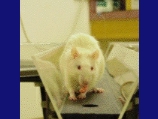 |
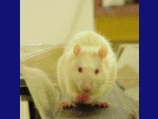 |
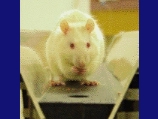 |

In
vitro study of synaptic plasticity in the developing corpus callosum.
Honor's Project '98-99 Alex Goddard |
Coronal slices from 8-12 day old Long Evans rats. Recording electrode
is to the left (16 wires projecting into the slice). The stimulating electrode
is the single wire placed in the white matter contralateral to the recording
array.
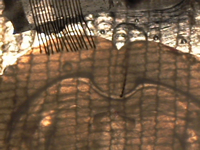 |
 |
|
| Transluminated. |
Illuminated from above.
Cuts were made to determine the trajectory of the fibers responsible for
evoked response. |
|

Graph illustrates the result of a sustained 1 Hz tetanus on evoked responses
recorded at different electrodes in the contralateral hemisphere.
Pretetanus recordings are traced with a solid line. Post tetanus recordings
are traced with broken lines. The different colors represent the different
electrodes (1, 5, 10 & 15). |
The methods for recording and analysizing the data are described
in
METHODS FOR STUDYING THE CONDUCTANCE CHANGES ASSOCIATED WITH SYNAPTIC ACTIVATION
OF FOREBRAIN SLICES - THE INTERPRETATION OF FIELD POTENTIALS USING CSD PROFILES
BORRONI AM, VAKNIN G, BERRY R, TEYLER TJ
JOURNAL OF NEUROSCIENCE METHODS
39 (1): 89-102 AUG 1991
&
AN INTEGRATED MULTIELECTRODE ELECTROPHYSIOLOGY SYSTEM
BORRONI A, CHEN FM, LECURSI N, GROVER LM, TEYLER TJ
JOURNAL OF NEUROSCIENCE METHODS
36 (2-3): 177-184 FEB 1991
___________________________________
The methods described above were used to investigate other
phenomenon as described in
HYPERPOLARIZING AND DEPOLARIZING GABA-A RECEPTOR-MEDIATED DENDRITIC INHIBITION
IN AREA CA1 OF THE RAT HIPPOCAMPUS
LAMBERT NA, BORRONI AM, GROVER LM, TEYLER TJ
JOURNAL OF NEUROPHYSIOLOGY
66 (5): 1538-1548 NOV 1991

|
Effects
of polyamine analogs on synaptic transmission in the hippocampal slice.
Summer Research '97
|
This project assayed hippocampal transmission using the invitro slice technique.
Four undergraduates (April Ladavac ('98), Katherine Roberts ('98), Pia Bose
('98), Kelley Rosborough ('99), O'Dhaniel Mullette-Gillman ('98)) along with
Gigi Knight and myself setup the equipment, did some trouble shooting, collected
data, and analyzed the data. We tested four analogs of spermine:
1,4-diguanidinobutane (arcaine sulfate), 1,8-diaminooctane, 1,10-diaminodecane,
1,12 diaminododecane. None of these drugs had consistent effects
on the evoked response. However, students received invaluable hands-on experience
with electrophysiological techniques, troubleshooting electrical problems, in
vitro slices, data collection and data analysis.
Equipment:
This work was an extension of the work described in:
METHODS FOR STUDYING THE CONDUCTANCE CHANGES ASSOCIATED WITH SYNAPTIC ACTIVATION
OF FOREBRAIN SLICES - THE INTERPRETATION OF FIELD POTENTIALS USING CSD PROFILES
BORRONI AM, VAKNIN G, BERRY R, TEYLER TJ
JOURNAL OF NEUROSCIENCE METHODS
39 (1): 89-102 AUG 1991

Summer
Research '97
Simulation of hippocampal dependent searching behavior in rats.
|
This project was undertaken in collaboration with researchers
at Louisiana State University, Tennessee State University, and the Northeastern
Ohio Universities College of Medicine (Kent State University). This program
is designed to mimic the ability of a rat to navigate in an open environment
(spatial navigation). The simulation consists of four layers of 'neurons'
linked together in various ways. The linkages and layer configurations
are constrained by the anatomy of the rat hippocampal region - a region critical
for spatial navigation. Here at Oberlin we tested various network configurations
and learning rules to see which combinations produced the best results
in terms of allowing our simulated rat to produce a find a 'goal' in it's open
environment. John Matney (OC'99) did most of the work. He collect
pertinent data consisting of vector quantities calculated after the network
had stabilized and the number of 'steps' the simulated rat needed to find the
goal after it had time to orient itself to it's new environment. John
patiently collected data from 2016 different configurations. Along with the
data collected by Matt Chow at NEOUCOM we were able to rank order the various
configurations for efficacy in learning the task. The next step will be
to further legitimize the network with respect to hippocampal anatomy and determine
which factors are most critical for learning to occur within a given network
configuration.

We are running the simulator on a PowerPC. The figure
is an example of the interface. The box in the bottom right represents the field
in which the rat is navigating. The red circle is the goal and the
vectors are built during the explore phase and later used to find the goal during
the search phase.
Sponsored independent study/private reading projects:
Ethan Meyers (Spring 2001) : Private reading: Neural Networks.
Using Computational Neuroscience textbook by K & O'Reilly tried to create neural
network usign C++ http://occs.cs.oberlin.edu/~emeyers/Research/research.html
[ Home ] [Classes ]
[Travel] [Research] [OCTET]

